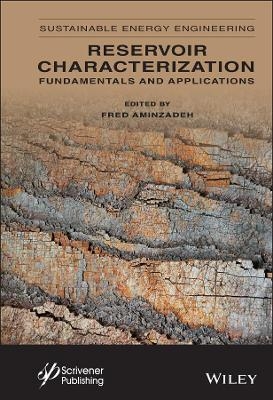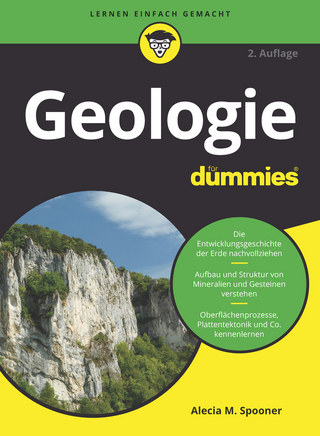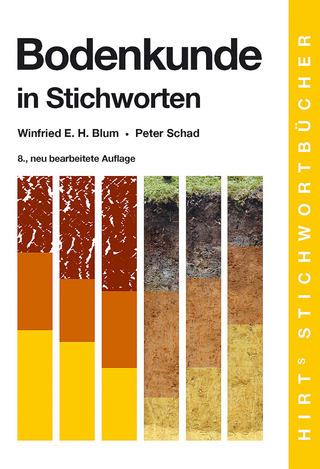
Reservoir Characterization
Wiley-Scrivener (Verlag)
978-1-119-55621-3 (ISBN)
Long thought of as not being “sustainable,” newly discovered sources of petroleum and newly developed methods for petroleum extraction have made it clear that not only can the petroleum industry march toward sustainability, but it can be made “greener” and more environmentally friendly. Sustainable energy engineering is where the technical, economic, and environmental aspects of energy production intersect and affect each other.
This collection of papers covers the strategic and economic implications of methods used to characterize petroleum reservoirs. Born out of the journal by the same name, formerly published by Scrivener Publishing, most of the articles in this volume have been updated, and there are some new additions, as well, to keep the engineer abreast of any updates and new methods in the industry.
Truly a snapshot of the state of the art, this groundbreaking volume is a must-have for any petroleum engineer working in the field, environmental engineers, petroleum engineering students, and any other engineer or scientist working with reservoirs.
This outstanding new volume:
Is a collection of papers on reservoir characterization written by world-renowned engineers and scientists and presents them here, in one volume
Contains in-depth coverage of not just the fundamentals of reservoir characterization, but the anomalies and challenges, set in application-based, real-world situations
Covers reservoir characterization for the engineer to be able to solve daily problems on the job, whether in the field or in the office
Deconstructs myths that are prevalent and deeply rooted in the industry and reconstructs logical solutions
Is a valuable resource for the veteran engineer, new hire, or petroleum engineering student
Fred Aminzadeh, PhD, is a world-renowned academic and scientist in the energy industry. With over 20 years of teaching experience at the University of Southern California and at the University of Houston, he also has extensive industry experience not only in oil and gas, but also in geothermal energy and other areas of energy. He also served as the president of Society of Exploration Geophysicists. He has been author of multiple books and has written numerous papers that have been well-received by academics and industry experts alike. He served as the editor in chief of the journal, The Journal of Sustainable Energy Engineering, formerly of Scrivener Publishing. He is currently editing the series, “Sustainable Energy Engineering,” for the Wiley-Scrivener imprint.
Foreword xix
Preface xxiii
Part 1: Introduction 1
1 Reservoir Characterization: Fundamental and Applications - An Overview 3
Fred Aminzadeh
1.1 Introduction to Reservoir Characterization? 3
1.2 Data Requirements for Reservoir Characterization 5
1.3 SURE Challenge 7
1.4 Reservoir Characterization in the Exploration, Development and Production Phases 10
1.4.1 Exploration Stage/Development Stage 10
1.4.2 Primary Production Stage 11
1.4.3 Secondary/Tertiary Production Stage 11
1.5 Dynamic Reservoir Characterization (DRC) 12
1.5.1 4D Seismic for DRC 13
1.5.2 Microseismic Data for DRC 14
1.6 More on Reservoir Characterization and Reservoir Modeling for Reservoir Simulation 15
1.6.1 Rock Physics 16
1.6.2 Reservoir Modeling 17
1.7 Conclusion 20
References 20
Part 2: General Reservoir Characterization and Anomaly Detection 23
2 A Comparison Between Estimated Shear Wave Velocity and Elastic Modulus by Empirical Equations and that of Laboratory Measurements at Reservoir Pressure Condition 25
Haleh Azizia, Hamid Reza Siahkoohi, Brian Evans, Nasser Keshavarz Farajkhah and Ezatollah KazemZadeh
2.1 Introduction 26
2.2 Methodology 28
2.1.2 Estimating the Shear Wave Velocity 28
2.2.2 Estimating Geomechanical Parameters 31
2.3 Laboratory Set Up and Measurements 32
2.3.1 Laboratory Data Collection 34
2.4 Results and Discussion 35
2.5 Conclusions 41
2.6 Acknowledgment 43
References 43
3 Anomaly Detection within Homogenous Geologic Area 47
Simon Katz, Fred Aminzadeh, George Chilingar and Leonid Khilyuk
3.1 Introduction 48
3.2 Anomaly Detection Methodology 49
3.3 Basic Anomaly Detection Classifiers 50
3.4 Prior and Posterior Characteristics of Anomaly Detection Performance 52
3.5 ROC Curve Analysis 55
3.6 Optimization of Aggregated AD Classifier Using Part of the Anomaly Identified by Universal Classifiers 58
3.7 Bootstrap Based Tests of Anomaly Type Hypothesis 61
3.8 Conclusion 64
References 65
4 Characterization of Carbonate Source-Derived Hydrocarbons Using Advanced Geochemical Technologies 69
Hossein Alimi
4.1 Introduction 70
4.2 Samples and Analyses Performed 71
4.3 Results and Discussions 72
4.4 Summary and Conclusions 79
References 80
5 Strategies in High-Data-Rate MWD Mud Pulse Telemetry 81
Yinao Su, Limin Sheng, Lin Li, Hailong Bian, Rong Shi, Xiaoying Zhuang and Wilson Chin
5.1 Summary 82
5.1.1 High Data Rates and Energy Sustainability 82
5.1.2 Introduction 83
5.1.3 MWD Telemetry Basics 85
5.1.4 New Telemetry Approach 87
5.2 New Technology Elements 88
5.2.1 Downhole Source and Signal Optimization 89
5.2.2 Surface Signal Processing and Noise Removal 92
5.2.3 Pressure, Torque and Erosion Computer Modeling 93
5.2.4 Wind Tunnel Analysis: Studying New Approaches 96
5.2.5 Example Test Results 108
5.3 Directional Wave Filtering 111
5.3.1 Background Remarks 111
5.3.2 Theory 112
5.3.3 Calculations 116
5.4 Conclusions 132
Acknowledgments 133
References 133
6 Detection of Geologic Anomalies with Monte Carlo Clustering Assemblies 135
Simon Katz, Fred Aminzadeh, George Chilingar, Leonid Khilyuk and Matin Lockpour
6.1 Introduction 135
6.2 Analysis of Inhomogeneity of the Training and Test Sets and Instability of Clustering 136
6.3 Formation of Multiple Randomized Test Sets and Construction of the Clustering Assemblies 138
6.4 Irregularity Index of Individual Clusters in the Cluster Set 139
6.5 Anomaly Indexes of Individual Records and Clustering Assemblies 141
6.6 Prior and Posterior True and False Discovery Rates for Anomalous and Regular Records 142
6.7 Estimates of Prior False Discovery Rates for Anomalous Cluster Sets, Clusters, and Individual Records. Permeability Dataset 142
6.8 Posterior Analysis of Efficiency of Anomaly Identification. High Permeability Anomaly 144
6.9 Identification of Records in the Gas Sand Dataset as Anomalous, using Brine Sand Dataset as Data with Regular Records 146
6.10 Notations 149
6.11 Conclusions 149
References 150
7 Dissimilarity Analysis of Petrophysical Parameters as Gas-Sand Predictors 151
Simon Katz, George Chilingar, Fred Aminzadeh and Leonid Khilyuk
7.1 Introduction 152
7.2 Petrophysical Parameters for Gas-Sand Identification 152
7.3 Lithologic and Fluid Content Dissimilarities of Values of Petrophysical Parameters 154
7.4 Parameter Ranking and Efficiency of Identification of Gas-Sands 155
7.5 ROC Curve Analysis with Cross Validation 159
7.6 Ranking Parameters According to AUC Values 161
7.7 Classification with Multidimensional Parameters as Gas Predictors 163
7.8 Conclusions 164
Definitions and Notations 166
References 166
8 Use of Type Curve for Analyzing Non-Newtonian Fluid Flow Tests Distorted by Wellbore Storage Effects 169
Fahd Siddiqui and Mohamed Y. Soliman
8.1 Introduction 170
8.2 Objective 173
8.3 Problem Analysis 173
8.3.1 Model Assumptions 174
8.3.2 Solution Without the Wellbore Storage Distortion 175
8.3.3 Wellbore Storage and Skin Effects 175
8.3.4 Solution by Mathematical Inspection 175
8.3.5 Solution Verification 176
8.4 Use of Finite Element 176
8.5 Analysis Methodology 177
8.5.1 Finding the n Value 177
8.5.2 Dimensionless Wellbore Storage 178
8.5.3 Use of Type Curves 178
8.5.4 Match Point 179
8.5.5 Uncertainty in Analysis 180
8.6 Test Data Examples 180
8.6.1 Match Point 182
8.6.2 Match Point 183
8.6.3 Analysis Recommendations 185
8.6.4 Match Point 185
8.6.5 Analysis Recommendations 186
8.6.6 Match point 186
8.7 Conclusion 188
Nomenclature 188
References 189
Appendix A: Non-Linear Boundary Condition and Laplace Transform 189
Appendix B: Type Curve Charts for Various Power Law Indices 191
Part 3: Reservoir Permeability Detection 195
9 Permeability Prediction Using Machine Learning, Exponential, Multiplicative, and Hybrid Models 197
Simon Katz, Fred Aminzadeh, George Chilingar and M. Lackpour
9.1 Introduction 197
9.2 Additive, Multiplicative, Exponential, and Hybrid Permeability Models 198
9.3 Combination of Basis Function Expansion and Exhaustive Search for Optimum Subset of Predictors 200
9.4 Outliers in the Forecasts Produced with Four Permeability Models 201
9.5 Additive, Multiplicative, and Exponential Committee Machines 203
9.6 Permeability Forecast with First Level Committee Machines. Sandstone Dataset 206
9.7 Permeability Prediction with First Level Committee Machines. Carbonate Reservoirs 210
9.8 Analysis of Accuracy of Outlier Replacement by The First and Second Level Committee Machines. Sandstone Dataset 212
9.9 Conclusion 214
Notations and Definitions 215
References 216
10 Geological and Geophysical Criteria for Identifying Zones of High Gas Permeability of Coals (Using the Example of Kuzbass CBM Deposits) 217
A.G. Pogosyan
10.1 Introduction 217
10.2 Physical Properties and External Load Conditions on a Coal Reservoir 219
10.3 Basis for Evaluating Physical and Mechanical Coalbed Properties in the Borehole Environment 225
10.4 Conclusions 228
Acknowledgement 228
References 229
11 Rock Permeability Forecasts Using Machine Learning and Monte Carlo Committee Machines 231
Simon Katz, Fred Aminzadeh, Wennan Long, George Chilingar and Matin Lackpour
11.1 Introduction 232
11.2 Monte Carlo Cross Validation and Monte Carlo Committee Machines 233
11.3 Performance of Extended MC Cross Validation and Construction MC Committee Machines 236
11.4 Parameters of Distribution of the Number of Individual Forecasts in Monte Carlo Cross Validation 237
11.5 Linear Regression Permeability Forecast with Empirical Permeability Models 238
11.6 Accuracy of the Forecasts with Machine Learning Methods 242
11.7 Analysis of Instability of the Forecast 244
11.8 Enhancement of Stability of the MC Committee Machines Forecast Via Increase of the Number of Individual Forecasts 246
11.9 Conclusions 247
Nomenclature 247
Appendix 1- Description of Permeability Models from Different Fields 248
Appendix 2- A Brief Overview of Modular Networks or Committee Machines 249
References 251
Part 4: Reserves Evaluation/Decision Making 253
12 The Gulf of Mexico Petroleum System – Foundation for Science-Based Decision Making 255
Corinne Disenhof, MacKenzie Mark-Moser and Kelly Rose
Introduction 256
Basin Development and Geologic Overview 257
Petroleum System 259
Reservoir Geology 259
Hydrocarbons 261
Salt and Structure 262
Conclusions 263
Acknowledgments and Disclaimer 264
References 265
13 Forecast and Uncertainty Analysis of Production Decline Trends with Bootstrap and Monte Carlo Modeling 269
Simon Katz, George Chilingar and Leonid Khilyuk
13.1 Introduction 270
13.2 Simulated Decline Curves 271
13.3 Nonlinear Least Squares for Decline Curve Approximation 273
13.4 New Method of Grid Search for Approximation and Forecast of Decline Curves 273
13.5 Iterative Minimization of Least Squares with Multiple Approximating Models 275
13.6 Grid Search Followed by Iterative Minimization with Levenberg-Marquardt Algorithm 276
13.7 Two Methods for Aggregated Forecast and Analysis of Forecast Uncertainty 277
13.8 Uncertainty Quantile Ranges Obtained Using Monte Carlo and Bootstrap Methods 279
13.9 Monte Carlo Forecast and Analysis of Forecast Uncertainty 280
13.10 Block Bootstrap Forecast and Analysis of Forecast Uncertainty 284
13.11 Comparative Analysis of Results of Monte Carlo and Bootstrap Simulations 285
13.12 Conclusions 287
References 288
14 Oil and Gas Company Production, Reserves, and Valuation 289
Mark J. Kaiser
14.1 Introduction 290
14.2 Reserves 292
14.2.1 Proved Reserves 292
14.2.2 Proved Reserves Categories 292
14.2.3 Reserves Reporting 293
14.2.4 Probable and Possible Reserves 293
14.2.5 Contractual Differences 294
14.3 Production 294
14.4 Factors that Impact Company Value 295
14.4.1 Ownership 295
14.4.1.1 International Oil Companies 295
14.4.1.2 National Oil Companies 296
14.4.1.3 Government Sponsored Entities 296
14.4.1.4 Independents and Juniors 297
14.4.2 Degree of Integration 297
14.4.3 Product mix 298
14.4.4 Commodity Price 298
14.4.5 Production Cost 299
14.4.6 Finding Cost 299
14.4.7 Assets 300
14.4.8 Capital Structure 300
14.4.9 Geologic Diversification 301
14.4.10 Geographic Diversification 301
14.4.11 Unobservable Factors 302
14.5 Summary Statistics 303
14.5.1 Sample 303
14.5.2 Variables 303
14.5.3 Data Source 305
14.5.4 International Oil Companies 305
14.5.5 Independents 308
14.6 Market Capitalization 309
14.6.1 Functional Specification 309
14.6.2 Expectations 309
14.7 International Oil Companies 310
14.8 U.S. Independents 312
14.8.1 Large vs. Small Cap, Oil vs. Gas 312
14.8.2 Consolidated Small-Caps 314
14.8.3 Multinational vs. Domestic 314
14.8.4 Conventional vs. Unconventional 315
14.8.5 Production and Reserves 316
14.8.6 Regression Models 316
14.9 Private Companies 318
14.10 National Oil Companies of OPEC 320
14.11 Government Sponsored Enterprises and Other International Companies 320
14.12 Conclusions 323
References 324
Part 5: Unconventional Reservoirs 337
15 An Analytical Thermal-Model for Optimization of Gas-Drilling in Unconventional Tight-Sand Reservoirs 339
Boyun Guo, Gao Li and Jinze Song
15.1 Introduction 340
15.2 Mathematical Model 341
15.3 Model Comparison 346
15.4 Sensitivity Analysis 348
15.5 Model Applications 349
15.6 Conclusions 351
Nomenclature 352
Acknowledgements 353
References 353
Appendix A: Steady Heat Transfer Solution for Fluid Temperature in Counter-Current Flow 355
Assumptions 355
Governing Equation 355
Boundary Conditions 360
Solution 360
16 Development of an Analytical Model for Predicting the Fluid Temperature Profile in Drilling Gas Hydrates Reservoirs 363
Liqun Shan, Boyun Guo and Xiao Cai
16.1 Introduction 364
16.2 Mathematical Model 365
16.3 Case Study 373
16.4 Sensitivity Analysis 374
16.5 Conclusions 377
Acknowledgements 378
Nomenclature 378
References 379
17 Distinguishing Between Brine-Saturated and Gas-Saturated Shaly Formations with a Monte-Carlo Simulation of Seismic Velocities 383
Simon Katz, George Chilingar and Leonid Khilyuk
17.1 Introduction 384
17.2 Random Models for Seismic Velocities 385
17.3 Variability of Seismic Velocities Predicted by Random Models 387
17.4 The Separability of (Vp , Vs ) Clusters for Gas- and Brine-Saturated Formations 388
17.5 Reliability Analysis of Identifying Gas-Filled Formations 389
17.5.1 Classification with K-Nearest Neighbor 391
17.5.2 Classification with Recursive Partitioning 392
17.5.3 Classification with Linear Discriminant Analysis 394
17.5.4 Comparison of the Three Classification Techniques 395
17.6 Conclusions 396
References 397
18 Shale Mechanical Properties Influence Factors Overview and Experimental Investigation on Water Content Effects 399
Hui Li, Bitao Lai and Shuhua Lin
18.1 Introduction 400
18.2 Influence Factors 400
18.2.1 Effective Pressure 401
18.2.2 Porosity 402
18.2.3 Water Content 403
18.2.4 Salt Solutions 405
18.2.5 Total Organic Carbon (TOC) 406
18.2.6 Clay Content 407
18.2.7 Bedding Plane Orientation 408
18.2.8 Mineralogy 411
18.2.9 Anisotropy 413
18.2.10 Temperature 413
18.3 Experimental Investigation of Water Saturation Effects on Shale’s Mechanical Properties 414
18.3.1 Experiment Description 414
18.3.2 Results and Discussion 414
18.3.3 Error Analysis of Experiments 417
18.4 Conclusions 418
Acknowledgements 420
References 420
Part 6: Enhance Oil Recovery 427
19 A Numerical Investigation of Enhanced Oil Recovery Using Hydrophilic Nanofuids 429
Yin Feng, Liyuan Cao and Erxiu Shi
19.1 Introduction 430
19.2 Simulation Framework 432
19.2.1 Background 432
19.2.2 Two Essential Computational Components 433
19.2.2.1 Flow Model 433
19.2.2.2 Nanoparticle Transport and Retention Model 435
19.3 Coupling of Mathematical Models 437
19.4 Verification Cases 439
19.4.1 Effect of Time Steps on the Performance of the in House Simulator 439
19.4.2 Comparison with Eclipse 440
19.4.3 Comparison with Software MNM1D 442
19.5 Results 443
19.5.1 Continuous Injection 445
19.5.1.1 Effect of Injection Time on Oil Recovery and Nanoparticle Adsorption 445
19.5.1.2 Effect of Injection Rate on Oil Recovery and Nanoparticle Adsorption 447
19.5.2 Slug Injection 449
19.5.2.1 Effect of Injection Time on Oil Recovery and Nanoparticle Adsorption 449
19.5.2.2 Effect of Slug Size on Oil Recovery and Nanoparticle Adsorption 451
19.5.3 Water Postflush 452
19.5.3.1 Effect of Injection Time Length 452
19.5.3.2 Effect of Flow Rate Ratio Between Water and Nanofuids on Oil and Nanoparticle Recovery 452
19.5.4 3D Model Showcase 455
19.6 Discussions 457
19.7 Conclusions and Future Work 459
References 461
20 3D Seismic-Assisted CO2 -EOR Flow Simulation for the Tensleep Formation at Teapot Dome, USA 463
Payam Kavousi Ghahfarokhi, Thomas H. Wilson and Alan Lee Brown
20.1 Presentation Sequence 464
20.2 Introduction 464
20.3 Geological Background 468
20.4 Discrete Fracture Network (DFN) 469
20.5 Petrophysical Modeling 473
20.6 PVT Analysis 473
20.7 Streamline Analysis 479
20.8 Co2 -EOR 479
20.9 Conclusions 483
Acknowledgement 483
References 484
Part 7: New Advances in Reservoir Characterization-Machine Learning Applications 487
21 Application of Machine Learning in Reservoir Characterization 489
Fred Aminzadeh
21.1 Brief Introduction to Reservoir Characterization 489
21.2 Artificial Intelligence and Machine (Deep) Learning Review 491
21.2.1 Support Vector Machines 492
21.2.2 Clustering (Unsupervised Classification) 492
21.2.3 Ensemble Methods 497
21.2.4 Artificial Neural Networks (ANN)- Based Methods 498
21.3 Artificial Intelligence and Machine (Deep) Learning Applications to Reservoir Characterization 502
21.3.1 3D Structural Model Development 503
21.3.2 Sedimentary Modeling 506
21.3.3 3D Petrophysical Modeling 508
21.3.4 Dynamic Modeling and Simulations 512
21.4 Machine (Deep) Learning and Enhanced Oil Recovery (EOR) 513
21.4.1 ANNs for EOR Performance and Economics 514
21.4.2 ANNs for EOR Screening 516
21.5 Conclusion 517
Acknowledgement 518
References 518
Index 525
| Erscheinungsdatum | 27.01.2022 |
|---|---|
| Sprache | englisch |
| Maße | 10 x 10 mm |
| Gewicht | 454 g |
| Themenwelt | Naturwissenschaften ► Chemie |
| Naturwissenschaften ► Geowissenschaften ► Geologie | |
| Technik | |
| ISBN-10 | 1-119-55621-X / 111955621X |
| ISBN-13 | 978-1-119-55621-3 / 9781119556213 |
| Zustand | Neuware |
| Informationen gemäß Produktsicherheitsverordnung (GPSR) | |
| Haben Sie eine Frage zum Produkt? |
aus dem Bereich


